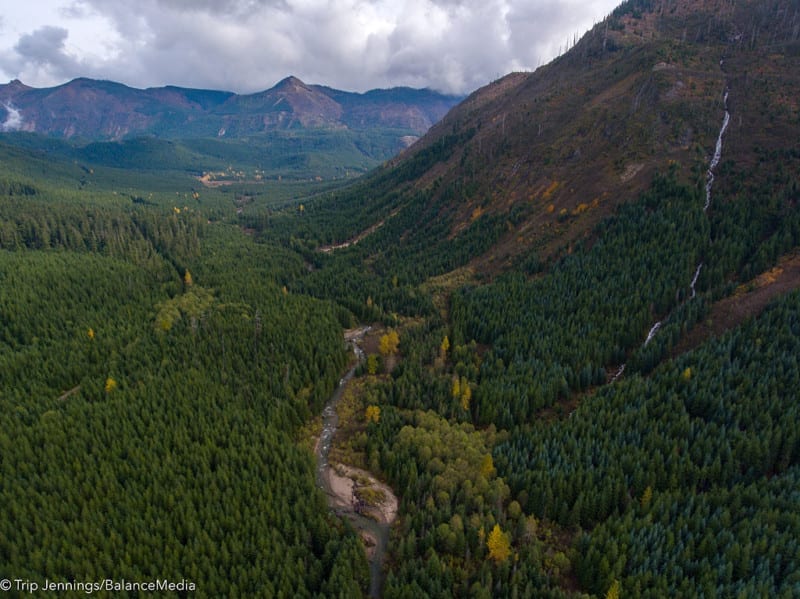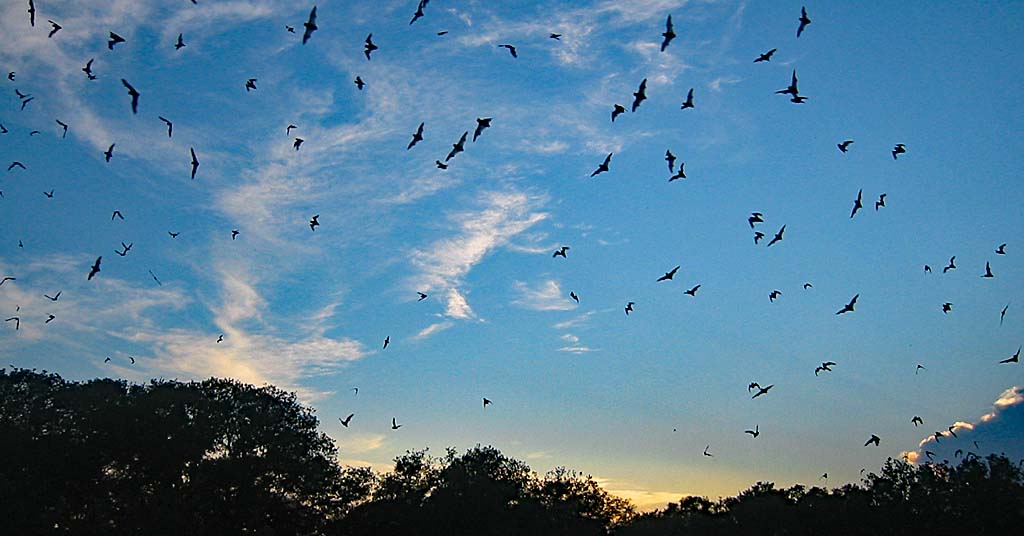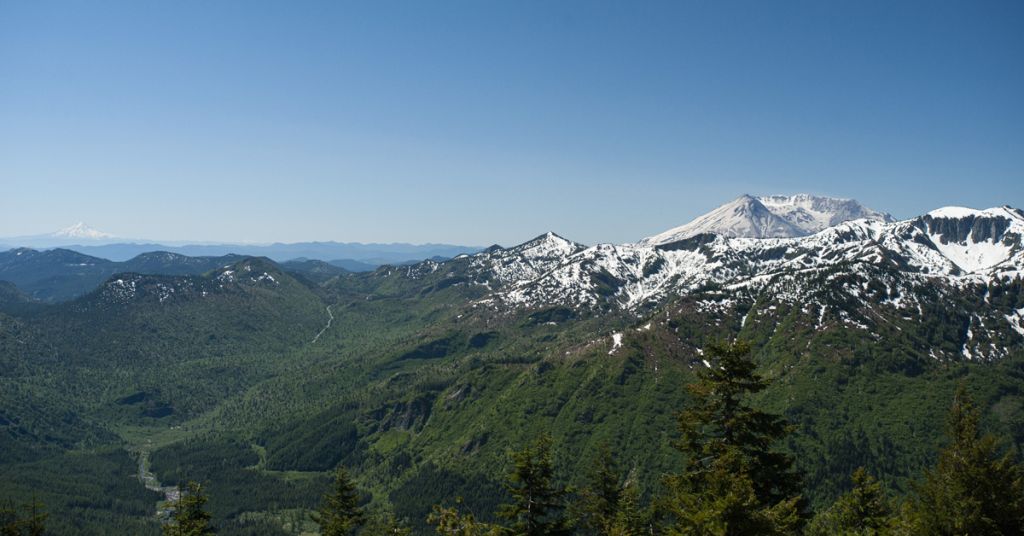USFS green-lights exploratory mining in the upper Green River valley
By Dac Collins. July 19, 2018. Among the freshwater gems that drain the western slopes of the Cascades, southwest Washington’s Green River is the coveted emerald. The remote upper section of river, located within the Gifford Pinchot National Forest, is a state-designated gene bank for endangered wild steelhead, while its lower reaches provide clean drinking water for residents of the Cowlitz Valley.
But a coalition of environmental organizations say the Green is also one of the Pacific Northwest’s most endangered watersheds due to the U.S. Forest Service’s recent decision to allow a Canadian prospecting company to conduct exploratory hard-rock mining near its headwaters.
The headwaters of the Green lie just to the northeast and outside of Mt. St. Helens National Volcanic Monument in a steep, remote and incredibly lush valley. And because of its location within the northern fringes of the 1980 ‘blast zone’, the river snakes westward through a geologically unique and relatively newborn ecosystem. Still the focus of numerous research projects, the nearly 230 square-mile area known as the blast zone encompasses regenerating blown-down forests, remnants of old-growth stands and windswept pumice plains peppered with wildflowers. It features drainages that were scoured by violent mudslides, supports herds of elk and other wildlife, and represents some of the best true wilderness recreation opportunities in Washington’s South Cascades. The entire region is a fascinating study in the resiliency of the natural world.
The Green is also considered a stronghold for anadromous fish. A major tributary of the Cowlitz River, which consistently ranks as one of Washington’s top producing steelhead streams, the pristine upper reaches of the Green River make up some of the best spawning habitat in the entire Lower Columbia River Basin. In 2014, the state designated the river a “Wild Steelhead Gene Bank” for both summer- and winter-run fish, which ensures that all hatchery fish are excluded from this extremely sensitive and unique riparian sanctuary.
So it comes as no surprise that thousands of Northwesterners—including a handful of federal politicians and over 20 conservation groups—see the prospect of industrial hard-rock mining around the Green’s headwaters as an immediate and intolerable threat.
Background
While the history of mining in the upper Green River watershed dates back to a brief but unproductive gold rush at the turn of the 20th century, recent efforts to extract gold, copper and molybdenum from the area represent their own convoluted chapter in the region’s history.
In 1969, the Duval Corporation purchased mining rights to the Green River valley (also known as the Mount Margaret) deposits and proceeded to drill 150 core samples over the course of the following decade. Mining prospects were drastically altered by the 1980 eruption. The creation of the 110,000-acre national volcanic monument required a number of land swaps. And the Duval Corp. sold its claims. The Green River watershed was not included as part of the national monument. But the U.S. Forest Service purchased the land surrounding it in 1986 with money from the Land and Water Conservation Fund—a fund created with the intent of preserving public lands with high conservation and recreation values for future generations to enjoy.
To further complicate things, the Forest Service was given ownership of the land itself, while the mineral rights were given to the Bureau of Land Management. This means that anyone wanting to mine in the area had to receive express permission from both federal agencies.
There was only one attempt made to mine in the area during the next 18 years, and that permit application was turned down by the Bureau of Land Management in 1993. The next attempt came in 2004, when Idaho-based General Moly Inc. acquired a 50 percent stake in the Mount Margaret deposits and applied for a mining lease. This attempt also failed after the Cascade Forest Conservancy, a local conservation group rallied the support of over 30,000 nearby residents from Kelso, Longview and Castle Rock during the public comment period of the agency’s environmental assessment.
After a contentious four years, the BLM denied the permit.
Industrial mining interests kept an eye on the Mount Margaret mineral deposits, however, and in 2010, two years after it was denied a permit by the BLM, General Moly Inc. sold its mining rights to Ascot Resources, Ltd.
The Canadian prospecting company submitted a drilling plan within months, one that was quickly approved by the USFS. The Canadian company had begun extracting core samples by August of 2011, but an injunction filed by the Cascade Forest Conservancy halted the exploratory drilling.
Ascot submitted another permit application in late 2011, one that was likewise approved by both the USFS and the BLM, and then subsequently halted when the Cascade Forest Conservancy convinced federal courts to invalidate the permit in 2014. But the Canadian company began writing another application in early 2015.
Here we can fast-forward to earlier this year, when the Cowlitz Valley Ranger District announced in February that it found no significant impacts during its environmental assessment of Ascot’s drilling plan. It gave consent to the BLM to issue prospecting permits.
What’s at stake?
If the BLM follows suit and grants drilling permits to Ascot, exploratory mining activities will take place on roughly 900 acres of public lands in the upper Green River valley. The Canadian company will be allowed to drill 63 holes from 21 drill pads in order to locate deposits of copper, gold and molybdenum; some located less than 200 feet from Green River tributaries and approximately 400 feet from the river itself.
Vice President of Ascot Resources Kristina Howe maintains that exploratory drilling can be (and has been) done in a safe and environmentally conscious manner. “Ascot and its predecessors have conducted exploratory drilling in the area for many years without incident as we seek to map the mineral resource. Environmental protection is a top priority for us.”
Opponents, however, view the location of a mine as potentially catastrophic and unsustainable, since it is possible that Ascot would extract the minerals by constructing an open-pit mine. Opponents argue that the industrial-scale mine would not only destroy most of Goat Mountain, but it would severely jeopardize the drinking water of the thousands of people living in the Cowlitz valley downstream.
The tailing ponds that are synonymous with open-pit mines and act as giant waste deposits for sludge containing heavy metals (such as copper, lead, cyanide, cadmium, mercury and arsenic) are also notorious for failing and leaking into nearby streams. And the likelihood of these tailing ponds failing, they argue, is increased exponentially by the fact that the Green River lies in one of the most seismically active areas in the Northwest within sight of an active volcano that experts agree will erupt again at some point in the future. When (and not if) that happens, the earthen dams holding back the toxic sludge would be almost guaranteed to fail.
Because of the disastrous environmental consequences that a mine like this one portends, the Cascade Forest Conservancy (CFC) says it will continue to fight Ascot through litigation and with the help of a coalition of over 20 partners including American Rivers, Backcountry Horsemen of Washington, Washington Wild, Washington Trails Association, the Wild Steelhead Coalition and the Clark-Skamania Flyfishers. These organizations represent the vast significant number of individuals who recreate on public lands and have a stake in their conservation and protection.
“Tens of thousands of people have expressed opposition to this proposal due to its impacts on recreation, clean water, and native fish, in and around one of our most treasured National Monuments,” wrote CFC’s executive director Matt Little in a February press release. “Allowing mining activities in a pristine river valley alongside an active volcano is simply ludicrous. We will do all we can to stop it.”
David Moryc, Director of Wild and Scenic Rivers for American Rivers, echoed Little’s sentiments, saying that “as a wild steelhead sanctuary, and as a source of clean drinking water for downstream communities, the Green River, a [potential] Wild and Scenic River is the last place for a mine. The Forest Service should not be green-lighting mining on our public lands that were purchased explicitly for conservation and recreation purposes.”
The U.S. Forest Service, on the other hand, contends that it is allowing prospecting and not mining, which the agency views as an important distinction. In a thorough, 34-page “Decision Notice & Finding of No Significant Impact” that was written back in January, Cowlitz Valley District Ranger Gar Abbas further explains that distinction.
“My consent decision to the BLM facilitates only prospecting (exploration) activities within the prospecting permit areas. It is not a mineral leasing or development (mining) proposal,” Abbas writes.
“It has become clear there is a great deal of concern that this decision somehow makes the potential for future approval of a new mine in this area easier or more likely. This consent decision is not for a mineral lease or mining; it is specific to issuance of prospecting permits that would convey rights to the holder to conduct exploration operations subject to terms and conditions of the prospecting permits…any subsequent application for a lease of the Federal mineral estates would be subject to a separate National Environmental Policy Act (NEPA) analysis and public comment process, to be evaluated on its own merits, and would require a separate decision in which the Secretary of Agriculture, through the Forest Service, would deny or consent to leasing.”
Ascot’s Howe agrees with District Ranger Abbas when he says that it is a little too early to be worrying about the potential impacts of an open-pit mine that might not even be worth digging. After all, she says, the prospecting company has not yet determined if there is sufficient gold, copper and molybdenum in the area to make the project economically viable.
Neither Howe’s nor the District Ranger’s explanations are enough to ease the minds of concerned parties, however, who are quick to point out the risks of prospecting activities in such a location. They claim that any amount of exploratory drilling would damage the scenic integrity of the land because the noise and the presence of roads and machinery would take away from the solitude and the backcountry experience that such a remote location provides. They also point out that the drilling activities would mostly occur during the summer and fall, which coincides with peak recreation times for humans in the area as well as with breeding times for species such as elk and blacktail deer.
And from an underwater perspective, Steve Jones of the Clark-Skamania Flyfishers is quick to point out the inherent danger of copper and other metals leaching into the Green River. “Copper is a particular threat to steelhead and salmon,” he says. “Test drilling alone is likely to increase concentrations of dissolved copper entering the Green, and even brief spikes in the copper content of surface water interferes with the ability of steelhead and salmon to find habitat and spawn successfully.”
What’s next?
Ten years after the CFC first thwarted Ascot’s attempts at exploratory mining in the area, the group finds itself in a similar position arguing on the same basic principles.
“When the Forest Service purchased this land—and there’s a letter that states this—it was intended to preserve the Green River as it flows into the monument, and to preserve the scenic beauty of the Green River Valley,” says CFC’s policy and campaign manager Nicole Budine.
“The Land and Water Conservation Fund is a huge piece of this,” she says, “because typically [the fund] is used to protect areas from mining. Now we have this situation where exploratory drilling for copper, gold and molybdenum is proposed on a piece of land that was purchased with the LWCF fund.”
The Forest Conservancy and other opposition groups worry that permitting any type of mining on LWCF lands will create a precedent, one that could allow other LWCF lands across the country to be opened up to resource extraction.
Howe, for her part, says that the scope of the company’s exploration activity will be “very limited,” and that it will be closely monitored and regulated by the same federal agencies that “carefully considered the potential geologic impacts and determined any impacts would be ‘minor to insignificant.'”
“If there is a significant resource,” Howe says, “then we would need to develop a plan and go through another round of rigorous environmental permitting review. But until we know what resource exists, any talk of what comes next is premature.”
Now that the Forest Service has given its consent, CFC and its partners must wait for BLM to make its decision. At this point, she says, there is not much the public can do to influence the BLM, “but there is still an option for legislation to be passed which would remove this area from mining and protect it in the long term.”
The option Budine refers to is called a “mineral withdrawal”, and it would essentially take this area out of consideration for mining. “It’s not asking for it to be wilderness, it’s not asking for a high level of protection…it’s just asking for the baseline level of protection that the Forest Service essentially intended for it when they purchased it.”












